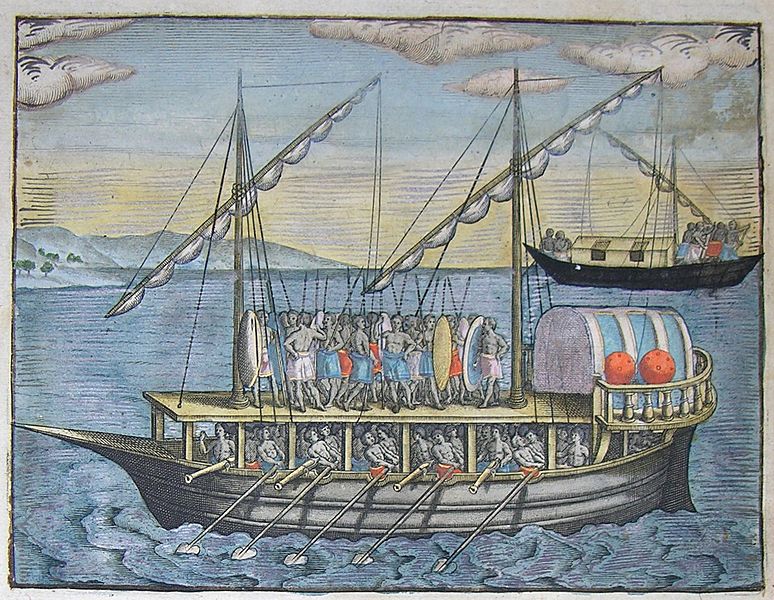Image: Galliot and Fusta of Java de Bry

Description: De Bry, Johann Theodor, (1560-1623) and Johann Israel de Bry (1565-1609). Part III, Plate 27, Small Indian Galley and Boat. From the "Little Voyages" GALLEONS AND BOATS IN BANTAM ASIAN VESSELS IN BANTAM The illustration shows four different types of vessel in the harbor of the trading town of Bantam on the northwestern tip of Java. The vessel on the left, with the high running aft and the two yards is called a iuncos in the journal, which is also called Junk, after the Javanese word Djong. Left we see a Chinese Junk. In the rear, there is a proa with a bowed prow and aft, used by the Javanese for trade along the coast. The foreground shows a proa with double outriggers. The Dutch called them 'kites', because they seemed to skim across the water so fast, it seemed as if they were flying. Small Indian galleons and boats They have boats and galleons named Cathurs by them which they used in times of war on which they carry 4 or 6 small canons the slaves are sitting on the lower level of the ship rowing: above on the deck the soldiers are standing on deck in their armor. The people on top of the ship are usually the most important colonels of Bantam. A lot of those ships consist of just one mast and one sail they use boat oars almost as we use them on our galleons, produced in Laffaon by Iaua, under instruction of the Turks who reside in Bantam. Description from A Collection of Voyages Undertaken by the Dutch East-India Company, for the Improvement of Trade and Navigation, which is a translation of De eerste schipvaart der Nederlanders naar Oost-Indië onder Cornelis de Houtman: They have Fustes and great Galleys at Bantam, but they can hardly preserve them, for they crack and open, though they keep them under a Roof to prevent such Accidents. They make use of them upon Expeditions or Sieges, but ’tis a long while before they get ’em ready to sail. Their Galiots are much like those in Europe, saving that they have only a Gallery at the Stern, and the Slaves or Rowers fit by themselves under the Deck, in Chains. The Soldiers are above them upon the Deck, that they may fight with more liberty. They have two Masts, and four Patereroes [original Dutch: Bassen - Breech-loading swivel gun] planted in the fore-part. The Praos or Pirogues serve to Cruise and Guard all the Islands against Pirates and other Accidents; they also make use of them to run Goods without paying the Duty. They have a Deck made like a Roof of a House, as well as the Pleasure-Barges, and no body can go to the Stern, but by going over the Deck. They have a great Mast, and a Mizzen-Mast, at the top and bottom of which is a long Reed. The Sails are made of twisted Herbs, or Leaves of Trees. Six Men row at the forepart, and two fit at the Stern to steer ; for they have two Helms, one on each side, and a Reed in the middle, fattened with a Rope under the Stern. All Jonques, and the other Vessels of that Country, have also two Helms.
Title: Galliot and Fusta of Java de Bry
Credit: Part III of Johann Theodor de Bry (1561-1623) and Johann Isreal de Bry's (1565-1609) Orientalische Indien (“Little Voyages”), Dritter Theil indiae orientalis...Frankfurt: 1599 (first edition)
Author: Johann Theodor de Bry (1560-1623) and Johann Israel de Bry (1565-1609)
Usage Terms: Public domain
License: Public domain
Attribution Required?: No
Image usage
There are no pages that link to this image.

